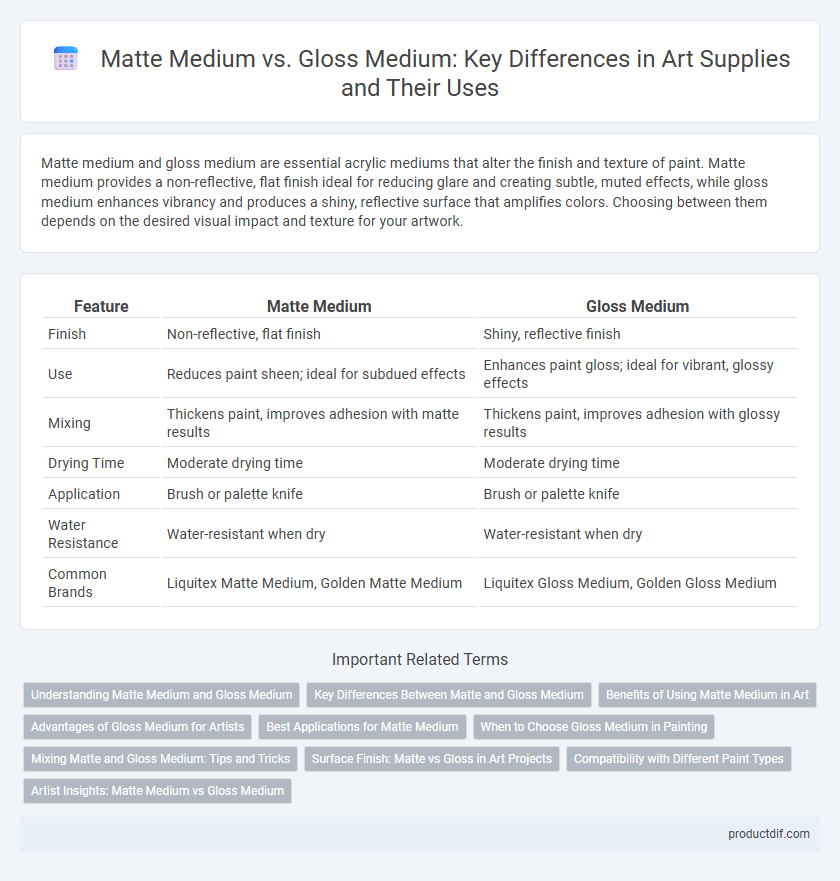Matte medium and gloss medium are essential acrylic mediums that alter the finish and texture of paint. Matte medium provides a non-reflective, flat finish ideal for reducing glare and creating subtle, muted effects, while gloss medium enhances vibrancy and produces a shiny, reflective surface that amplifies colors. Choosing between them depends on the desired visual impact and texture for your artwork.
Table of Comparison
| Feature | Matte Medium | Gloss Medium |
|---|---|---|
| Finish | Non-reflective, flat finish | Shiny, reflective finish |
| Use | Reduces paint sheen; ideal for subdued effects | Enhances paint gloss; ideal for vibrant, glossy effects |
| Mixing | Thickens paint, improves adhesion with matte results | Thickens paint, improves adhesion with glossy results |
| Drying Time | Moderate drying time | Moderate drying time |
| Application | Brush or palette knife | Brush or palette knife |
| Water Resistance | Water-resistant when dry | Water-resistant when dry |
| Common Brands | Liquitex Matte Medium, Golden Matte Medium | Liquitex Gloss Medium, Golden Gloss Medium |
Understanding Matte Medium and Gloss Medium
Matte medium and gloss medium are acrylic additives that modify the finish and texture of paint surfaces. Matte medium creates a non-reflective, flat finish ideal for reducing glare and enhancing color depth, while gloss medium produces a shiny, reflective surface that intensifies color vibrancy and offers increased durability. Both mediums improve paint adhesion and flexibility, allowing artists to customize the visual effect and tactile qualities of their artwork.
Key Differences Between Matte and Gloss Medium
Matte medium produces a flat, non-reflective finish suitable for muted or vintage effects, while gloss medium enhances color vibrancy with a shiny, reflective surface ideal for vivid, dynamic artwork. Matte medium typically dries faster and offers a more textured, absorbent surface compared to the smooth, slick finish of gloss medium. Artists choose between the two based on desired visual impact, drying time, and surface texture for various painting techniques.
Benefits of Using Matte Medium in Art
Matte Medium enhances the texture and depth of acrylic paintings by providing a non-reflective, velvety finish that reduces glare and allows for subtle color layering. It improves adhesion and flexibility of paint films, preventing cracking and prolonging artwork durability. Artists benefit from its ability to maintain true pigment colors while offering a smooth, professional matte surface ideal for mixed media applications.
Advantages of Gloss Medium for Artists
Gloss Medium enhances color vibrancy and depth, making artwork more visually striking with its shiny finish. It offers superior durability and water resistance, protecting paintings from moisture and wear over time. Its fast drying time and smooth application make it ideal for layering and achieving rich textures in mixed media projects.
Best Applications for Matte Medium
Matte medium is ideal for artists seeking a non-reflective, flat finish that enhances the opacity and texture of acrylic paints without altering their color intensity. It works best for layering techniques, glazing, and mixed media projects where reducing shine is essential to maintain visual depth and subtlety. Matte medium also improves adhesion on porous surfaces like canvas and paper, making it a preferred choice for fine art and collage applications.
When to Choose Gloss Medium in Painting
Gloss Medium enhances color vibrancy and provides a shiny, reflective finish ideal for creating depth and highlighting details in paintings. It is best chosen for artwork requiring a luminous effect or when glazing techniques are applied to intensify hues. Using Gloss Medium can also improve paint adhesion and durability on non-porous surfaces.
Mixing Matte and Gloss Medium: Tips and Tricks
Mixing matte and gloss mediums allows artists to customize the finish and texture of their acrylic paints, balancing sheen and opacity for desired effects. To achieve consistent results, start by blending small amounts to test the gloss level and adjust ratios gradually while stirring thoroughly to avoid uneven textures. Using a palette knife for mixing ensures a smooth, uniform consistency, enhancing paint adhesion and drying qualities without compromising color vibrancy.
Surface Finish: Matte vs Gloss in Art Projects
Matte medium creates a non-reflective, flat surface finish that reduces glare and enhances color saturation without shine, making it ideal for subtle, textured effects in art projects. Gloss medium produces a shiny, reflective surface that intensifies colors and highlights details, perfect for vibrant, polished artworks requiring a luminous finish. Choosing between matte and gloss mediums depends on the desired visual impact and the tactile quality of the final piece.
Compatibility with Different Paint Types
Matte medium and gloss medium differ significantly in their compatibility with various paint types, with matte medium being ideal for acrylic paints due to its ability to maintain color vibrancy without adding shine. Gloss medium works well with oil paints and acrylics when a reflective finish is desired, enhancing the depth and saturation of colors. Both mediums improve paint adhesion and flexibility, but selecting the appropriate medium depends on the desired finish and paint type, ensuring optimal durability and visual effect.
Artist Insights: Matte Medium vs Gloss Medium
Matte medium offers artists a non-reflective finish that preserves color integrity and texture, making it ideal for subtle, muted effects in acrylic painting. Gloss medium enhances vibrancy and depth by increasing color saturation and creating a shiny surface that intensifies highlights and details. Both mediums alter drying time and flexibility but choosing between them depends on the desired visual impact and the artwork's final presentation.
Matte Medium vs Gloss Medium Infographic

 productdif.com
productdif.com